Understanding the MIG Welding Process
Metal inert gas (MIG) welding is a type of arc welding that joins metal workpieces using an electric current, a consumable wire electrode, and an inert shielding gas such as helium or argon. The MIG welding process offers many advantages, making it a popular method for a wide range of applications and industries. Here, we will describe how MIG welding works, how it’s used, and its many unique benefits.
What Is MIG Welding?
MIG welding, also known as gas metal arc welding (GMAW), uses an adjustable, continuously fed solid wire electrode to create welded joints. This versatile and easily automated welding method only requires the welder to guide the welding gun along the fusion point at the proper orientation and position. An electric arc forms between the workpiece and the electrode, which generates enough heat to melt and join the metals.
How Is MIG Welding Used?
MIG welding utilizes an electrical current from a non-consumable or consumable solid wire electrode. As the electrical current generates heat, the filler materials melt to join two or more metal workpieces. In many cases, the filler material doubles as the electrode. This type of arc welding can be performed manually by a trained technician, or the process can be automated through moving equipment to ensure proper positioning and orientation.
Benefits of MIG Welding
Commonly used for welding steel materials, MIG welding is versatile, relatively fast, and easy to control, making it a popular welding technique for various applications. Other key benefits of MIG welding include:
- Speed. Compared to other welding methods such as TIG welding, MIG welding offers faster process speeds.
- Automated or manual. MIG welding units can be fully or partially automated, or they can be entirely manual based on the needs of each individual project.
- Ease of Use. MIG welding, though it requires a consumable electrode or filler material, is simple and easy to control. It also offers easy cleanup and a lack of chipping.
- Versatility. MIG welding can be used with stainless steel and multiple other materials. This technique is also versatile in terms of weld position and joint thickness.
- Environmentally friendly. The wire electrodes are fully consumed for minimal product waste, making MIG welding more environmentally friendly than alternative methods.
G.E. Mathis Company Welding Solutions
At G.E. Mathis Company, we use the latest manufacturing technology to offer precision MIG welding services for industries such as defense, construction, aerospace, and agriculture. Our state-of-the-art facilities are equipped with precision tooling equipment, Bluco fixture tables, and other varied fixtures that allow us to handle weldments of almost any size and shape. We can work with a wide range of metals and specialty alloys, including carbon steel, stainless steel, high-strength steel including STRENX® Performance Steel, and Abrasion-Resistant steel such as AR400, HARDOX® Wearplate, HARDOX® 450, and HARDOX® 500TUF .
In addition to being an ISO 9001:2015-certified manufacturer, G.E. Mathis Company can provide the following services:
- PPAP (Production Part Approval Process) – All Levels
- FAIR (First Article Inspection Report)
- Capability Studies (Statistical Process Control)
- CMRT (Conflict Minerals Reporting Template)
G.E. Mathis Company is dedicated to providing the highest levels of quality, craftsmanship, and integrity in the industry. We work with our customers to help them reach their goals by providing personalized service, expertise, and stringent quality assurance. For more information about our MIG welding services and other metalworking capabilities, contact us today or request a quote for your next project.
Considerations for Welding Stainless Steel
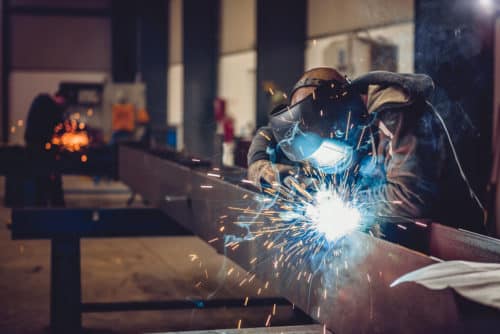
For more than a century, G.E. Mathis Company has been a reputable name in the metalworking industry. Our extensive selection of metal fabrication services includes specialized stainless steel welding for industries ranging from chemical manufacturing and food service to construction and defense.
Welding Process Overview
Stainless steel welding operates under the same basic welding principles as all metals. Just like other welding techniques, heat and sometimes pressure are applied to the base material at the point where you are joining two or more pieces of metal. Depending on the specific project and process, filler material may be melted along the joint and then allowed to cool.
The resultant material is a hard metal bonded to the surface material of each piece that holds them together in a solid joint. In order to prevent weak joints, the filler material must have a level of strength and hardness equal to the component pieces. The strength provided by the joining material is what ultimately provides a stronger bond when compared to other techniques, such as soldering or brazing.
Stainless Steel Welding Methods
Stainless steel welding typically involves some form of arc welding combined with specialized work holding solutions known as fixtures. Fixture welding uses a specialized tool to hold the stainless steel pieces in place. This ensures straight, clean welded seams without inconsistencies. To facilitate numerous clamp and brace configurations, a fixture table is constructed with numerous holes and openings.
This allows the welder to weld a wide range of sizes and shapes from numerous angles without worrying about unwanted movement or shifting. Fixture welding is particularly useful for stainless steel, as it allows a high degree of control over the position of the welding equipment and the component parts.
For the actual welding process, arc welding stainless steel offers the highest level of temperature control, which helps to ensure strong and accurate welds. In addition, a variety of filler materials can be used to improve weld strength when combined with the stainless steel material. The two most common arc welding techniques used with stainless steel include tungsten inert gas (TIG) welding and metal inert gas (MIG) welding. Each method uses a different approach to achieve the desired results.
Tungsten Inert Gas Welding
Tungsten inert gas (TIG) welding is a form of arc welding that uses a non-consumable tungsten electrode to create an arc of electrical current. The arc is shielded by an inert gas such as helium or argon and used to heat the filler material to weld multiple pieces together. TIG welding is highly valued for use in stainless steel welding because the level of heat can be easily controlled remotely with a foot pedal or fingertip controls.
Metal Inert Gas Welding
Metal inert gas (MIG) welding uses an electrical current from a consumable or non-consumable electrode. The heat generated by the electrical current is used to melt filler materials to join two or more metal pieces together. This form of arc welding can be automated or performed manually, and the filler material can double as the electrode.
G.E. Mathis Company Welding Solutions
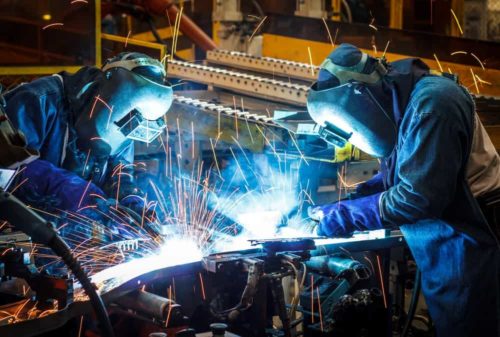
In addition to being an ISO 9001:2015-certified manufacturer, G.E. Mathis Company can provide the following services:
- PPAP (Production Part Approval Process) – All Levels
- FAIR (First Article Inspection Report)
- Capability Studies (Statistical Process Control)
- CMRT (Conflict Minerals Reporting Template)
G.E. Mathis Company is dedicated to providing the highest levels of quality, integrity, and craftsmanship in the industry. We help our customers reach their goals by providing a combination of expertise, rigorous quality assurance, and personalized service. To learn more about G.E. Mathis Company’s stainless steel welding and other metalworking capabilities, contact us or request a quote today.
The Versatility of HARDOX® Wear Plate
Specifically designed for use in harsh, demanding applications, HARDOX® Wear Plate provides an unmatched combination of hardness and toughness, allowing for extended service life and cost savings. This unique material is used across a wide range of industries to provide optimal reliability and wear resistance.
Why Is HARDOX® So Tough?
HARDOX® Wear Plate is a wear-resistant sheet steel developed by the Swedish company SSAB in 1974. This steel wears slowly, allowing the equipment used in abrasive applications and aggressive-wear environments to last longer, thereby reducing maintenance needs and costs.
HARDOX® offers a unique combination of hardness, strength, and toughness. The material’s high strength enables thinner metal sheets to be used, meaning products can be made to be simpler and lighter while still carrying high payloads. HARDOX® Wear Plate also has good impact resistance, even at low temperatures.
HARDOX® sheets and plates provide ideal welding and machining properties, simplifying production and repair work. To provide this excellent weldability, HARDOX® Wear Plate steel is manufactured to have a highly accurate chemical composition. Advanced hardening and post-treatment processes also help imbue it with its unique properties. The combination of high payloads, low maintenance costs, good availability, and long service life allows for overall cost savings while ensuring optimal reliability.
Finally, HARDOX® provides superior wear performance, crack safety, and deformation resistance provide defense against wear, dents, and cracks. To evaluate these properties, HARDOX® and ordinary high strength structural plates have been compared through comprehensive drop tests; in one test, weights varied between 330 and 1,800 pounds and were dropped from heights of up to 10 feet. The HARDOX® steel plate showed only moderate deformation, while the structural steel alternative couldn’t withstand the impact.
Advantages of HARDOX®
Extremely versatile, HARDOX® provides critical benefits for various industries. Below are some of the key features discussed above.
- Superior hardness — Offering excellent wear resistance, HARDOX® features all-around hardness that doesn’t impact structural performance.
- Excellent toughness — HARDOX® is able to resist cracks if subjected to deformation and can withstand heavy blows, allowing it to be easily bent, formed, and welded. Combined with its high yield strength, this durability also allows for the creation of lightweight designs.
- Consistency — HARDOX® retains its properties and strength even in severe, harsh conditions — and also during precision bending and forming, as well as precision welding and MIG welding — allowing for predictable, reliable results.
- Long service life — HARDOX® can double, or even triple, equipment wear plate service life, optimizing performance while minimizing the risk of damage.
Common HARDOX® Applications
HARDOX® unique properties make it well suited to a wide range of industries and applications, such as:
- Construction and demolition — HARDOX® can be used in various types of construction equipment, from evacuators and demolition tools to fragmentizers, all of which require high reliability and longevity to withstand heavy use and ensure worker safety.
- Mining — In this safety-critical industry, worker’s equipment — such as mining trucks — must be able to stand up to harsh conditions while maintaining a long lifespan; HARDOX® provides this reliability, cutting down on repair costs and delays.
- Military — HARDOX® Wear Plate provides the protective strength and reliability required in the military industry and is commonly used in the manufacture of armored vehicles.
STRENX® (Domex® ): High Performance, High Strength Steel
What Is STRENX®?
STRENX® is a High Strength, hot-rolled steel sheet also offered by SSAB; the steel is low-alloy and cold-formed. Previously called Domex, this unique material has been rebranded as STRENX.
The Advantages of STRENX®
Extremely versatile, STRENX® provides critical advantages for various industries. Some of its unique qualities and benefits include:
- Excellent versatility — This steel has excellent formability and good weldability, meaning it can undergo various manufacturing processes.
- Reduced production costs — Strenx allows for the manufacture of stronger, higher-quality products that require less steel and welding. This also allows for a lighter-weight product less susceptible to damage, saving money on repair and replacement costs in the long run.
Common STRENX® (Domex) Applications
The unique properties of STRENX® make it well-suited to a wide range of industries and applications, such as:
- Automotive — Designers like to keep structural weight low but strength-handling levels high. With Strenx, products made can be simpler and lighter while still carrying higher payloads.
- Construction and demolition — Strenx can be used in cranes and booms, both of which require high reliability and longevity to withstand heavy use and ensure optimal worker safety.
Learn More
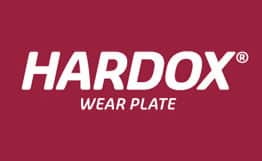
To learn more about the uses and unique properties of HARDOX® — which is ideal for a wide range of fabrication methods, including welding, cutting, bending, and bending — download our free eBook, “Fabricating Tougher Components with HARDOX® Wearparts.”
Understanding Different Types of Welding
An extremely versatile fabrication process, welding is used in nearly every industry, from agriculture and mining to construction and aerospace. Over the years, specialized welding techniques have been developed to better suit the needs of specific industry challenges, whether they involve fusing dissimilar metals or custom fabricating parts for critical-use applications.
To determine which type of welding is best suited for a specific project, welders must consider the physical properties of the workpiece and filler material, desired product specifications, necessary equipment and power supplies, and the customer’s timeframe.
Let’s look at some of today’s most widely used welding methods and how they differ:
Types of Welding
Submerged Arc Welding
Requiring a continuous electrode feed to create an arc between a welding rod and the workpiece, this type of welding adds a thick granular flux to form a shield. The result is a flux blanket, under which the arc is submerged to protect the weld zone from atmospheric contamination. This process can be automated, mechanized, or semi-automated through the use of hand-held guns.
Shielded Metal Arc Welding (SMAW)
Commonly referred to as “stick” welding, shielded metal arc welding (SMAW) is an inexpensive, manual process requiring a welding rod coated in flux, which carries a high-power electric current. During welding, the electrode’s flux coating breaks down, creating a layer of slag as well as a gas shield to protect the weld until it cools. Final products may require finishing services, however, as molten splatter is a common occurrence.
Gas Metal Arc Welding (GMAW)
Gas metal arc welding, also called MIG (metal inert gas) welding, is distinct in its use of an adjustable, continuous solid wire electrode feed. Versatile and easily automated, GMAW only requires that the welder guides the welding gun in the proper position and orientation along the fusion point. The electric arc formed between the electrode and the workpiece heats and melts the metals to join them.
Flux Core Arc Welding (FCAW)
Similar to MIG welding, flux core arc welding uses a tubular wire filled with flux in place of a solid wire. Dual-shielded FCAW uses the flux with an external shielding gas for protection, while self-shielded FCAW relies only on flux to protect the molten weld puddle, making this an ideal option for outdoor applications. As an automated process, FCAW is also popular for projects requiring quick turnaround times.
Gas Tungsten Arc Welding (GTAW)
Gas tungsten arc welding, more commonly referred to as TIG (tungsten inert gas) welding, uses a non-consumable tungsten welding rod (or electrode) to apply intense heat to the base metal. This produces an autogenous weld by melting two pieces of metal directly together without a filler. TIG welds are also protected by an external shielding gas — usually argon. This method produces strong, high-quality welds, though the process can be painstaking, requiring extreme focus and precision to weld the small space between the arc and the workpiece.
Specialty Welding at G.E. Mathis Company
At G.E. Mathis Company, our experienced, skilled team of sheet metal welders is certified to AWS D1.1, D1.6, D9.1, and D10.9 standards. We work regularly with carbon steel, stainless steel, and HARDOX® Wearplate.
In addition to being an ISO 9001:2015-certified manufacturer, G.E. Mathis Company can provide the following services:
- PPAP (Production Part Approval Process) – All Levels
- FAIR (First Article Inspection Report)
- Capability Studies (Statistical Process Control)
- CMRT (Conflict Minerals Reporting Template)
To learn more about specialty welding, or to discuss how our team of experts can help with your next project, contact us today.
Three Large-Scale Metal Components You Didn’t Know We Fabricated
G.E. Mathis Company began as a one-man operation in 1905. Since then, we have grown to occupy a 135,000 square foot facility in Chicago, IL, providing fabrication services using state-of-the-art technology. While we started small, our dedication to providing oversized components is recognized today throughout the industry.
Demanding industries rely on our knowledge, expertise, and fabrication skill to create large-scale, intricate fabrications at close tolerances. Our work encompasses jobs at every level of complexity and size.
Whether we are constructing custom roll-formed cylinders, a custom-welded boom-tube, or performing architectural laser cutting of stainless steel panels, G.E. Mathis Company construction projects are virtually limitless:
· Precision Laser-cut Architectural Panels
Our shop produced a set of intricate precision laser cut large panels. We cut each panel from A240-T304 stainless steel with our 6,000-watt laser, advancing from raw materials to fully finished, ready-to-install panels in just two weeks.
The final 91 individual architectural laser cut panels measured 0.25” thick by 63” wide by 163” tall, all of which now adorn a stunning outdoor installation.
· Rolled Cylinder Segments
Petroleum tanks require some of the industry’s largest fabrications. We partnered with an oil industry client to produce premium quality rolled steel cylinders for a tank assembly. Working from a customer-supplied print, we rolled 0.375” thick 304 stainless steel plates through our variable geometry 3-roll pinch-type plate rolling machine to produce 32 rolled segments.
After rolling, each cylinder section had a 300” interior radius through 45° and was 96” long. All 32 rolled segments arrived at their final destination within three weeks.
· Custom-welded Crane Boom
Cranes are essential for moving large-scale components; building them requires heavy-duty welded rectangular tubes. Our client needed a custom boom tube section for an enormous crane. Utilizing our submerged arc seam welder, we welded STRENX® (Domex) 100XF channels into rectangular tubes that measured ¼” thick by 18” by 20” by 240” long. After welding, we inspected each piece, and delivered them within a three week timeframe.
These pieces were noteworthy for their exceptional accuracy. Our skilled welders produced 50 of these welded boom-tubes at tolerances of ±0.125” and better.
Custom Solutions from GE Mathis
The examples above are just a sample of our precision custom products. At G.E. Mathis Company, we provide custom large-scale manufacturing for virtually every industry, including:
- Agricultural
- Architectural
- Chemical
- Construction
- Defense
- Energy
- Marine
- Mining
- Trailer / Truck body
- Contract manufacturing
- High-quality components
For more information about these projects, please see our portfolio gallery or contact one of our representatives directly today.
Welding Capabilities for the Construction Industry
Welding is instrumental to the success of a construction project. Not only is it a handy repair tool for broken and damaged machine parts, it is the mainstay of production supplying any construction endeavor with the required raw materials to progress at the desired pace.
It is undertaken by skilled operators and has to be performed according to pre-defined mandates and a set of compliance rules in order to ensure that the joints are strong and immune to jostling and rust.
WELDING, ITS IMPORTANCE AND IMPERATIVE IN CONSTRUCTION
All kinds of welding rely on generating an arc that is capable of raising the temperature of the parent material to the melting point. It is then fused with a filler metal which by rule of thumb is chosen to be structurally
stronger than the original base. Ranging from sub-merged arc to metal active gas to manual metal arc, different welding processes are leveraged at construction sites around the world to serve unique needs. Special ventures in the aerospace and naval industries have progressed to laser arc hybrid welding and electron beam technology.
An operation team manipulating welding equipment must be knowledgeable of the nuances of this technique in order to ensure the integrity of welded joints and thus by association created products. A large scale construction project is only as durable as the quality of its individual components.
Also according to the Consumer Justice Group report, welding tasked to untrained labor is an extremely hazardous proposition. Thousands of injuries occur right on-site because of careless handling of equipment or experimentation by unskilled staff.
SOME BEST PRACTICES TO KEEP IN MIND
As far as possible, complicated welding responsibilities must be left to professionals. Construction projects call for the employment of AWS (American Welding Society) certified welders who are cognizant of the involved risks and capable of handling them expertly.
Especially for the frequently used MIG (Metal Inert Gas) welding:
- Care should be taken to ensure that welders wear protective gear (including an auto-darkening face shield) to eliminate the riskofcontact burns and blisters
- Cotton is the chosen material because it doesn’t melt like polyester
- Be on the look-out for splatters of molten metal and grinding sparks which can cause a fire
- Avoid using galvanized steel as the parent material since it gives off carcinogenic vapors
G.E. MATHIS COMPANY AND ITS HISTORY OF EXCELLENCE:
G.E. Mathis Company has been an industry renowned name in the field of precision arc and MIG welding. We have perfected our craft over 100 years of rigorous practice assisting construction companies, OEMs, independent projects and manufacturers with their welding and rolling needs. ISO 9001:2015 certified, we are the gold standard in the welding and precision services domain.
Feel free to request a quote, or contact us today at 773.586.3800 and we will be glad to discuss how our fabrication and welding capabilities may help with your next project
Choosing the Right Material for Your Fabrication Needs
During the initial planning phase of fabrication, there are many things to consider. One of the most important of these considerations is material selection—what’s the absolute best choice for your part?
In industries and applications where the metal will be coming into contact with other hard materials that can wear it out due to abrasion, a good choice is an abrasion resistant (AR) plate. AR plates are designed for use in harsh environments.
Of course, there’s more than one type of AR plate. We recommend using HARDOX® Wearplate, which is chemically engineered to provide abrasion resistance throughout the entire thickness of the material, not just the surface. Many other AR plates only offer the abrasion resistance on the surfaces of the material, becoming softer towards the center of the material. Specific benefits of HARDOX® Wearplate include:
HARDOX® Wearplate is generally more formable.
- Readily weldable without pre- or post- heating (whereas pre- and post-heat may be necessary to prevent stress fractures in the material and the weld itself when using regular AR plates, no heat treatment is needed for HARDOX® Wearplate up to 2 inches).
- Longer part life as a result of even abrasion resistance throughout the thickness of the plate.
- HARDOX® Wearplate is blasted and primer coated at the mill, which results in material that better resists rusting and scaling.
While different machining processes and specific environments can affect material choice, as a general rule, when an AR plate is right for the job, HARDOX® Wearplate can be highly advantageous. In mining, construction, and other industries, it’s been known to save time, money, and worry. As an official HARDOX® Wearparts member, (one of only a handful in the country audited and authorized by SSAB, the maker of HARDOX® Wearplate), G.E. Mathis Company has a great deal of experience using it, and therefore is well aware of its benefits. When selecting abrasion-resistant material, put your confidence in a fabricator with a proven track record.






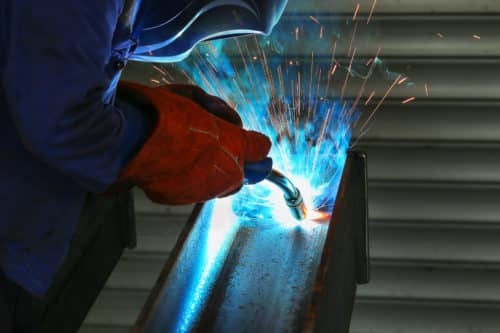
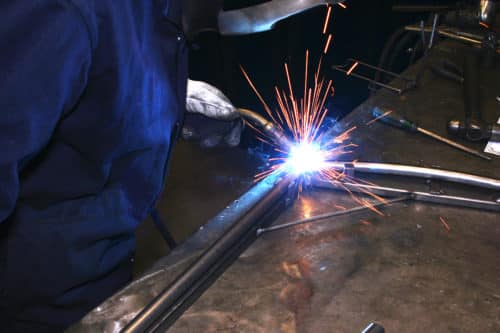
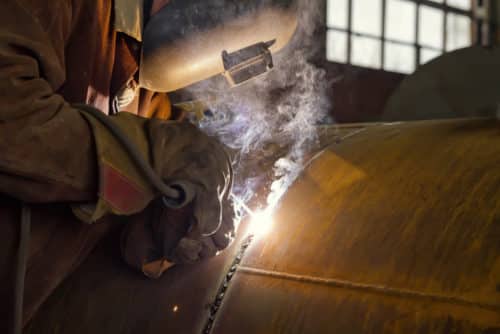
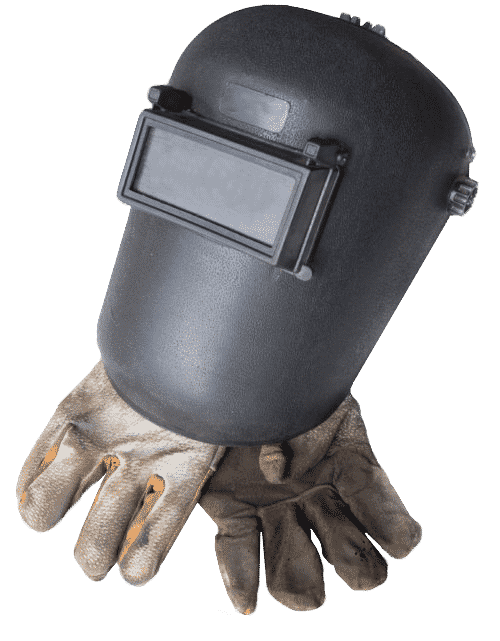
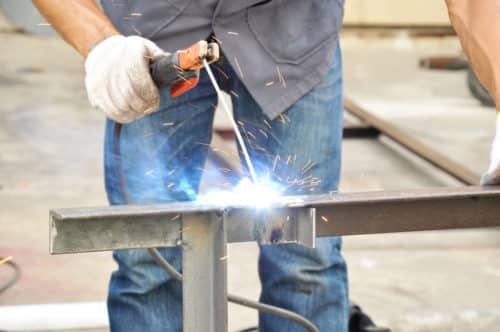
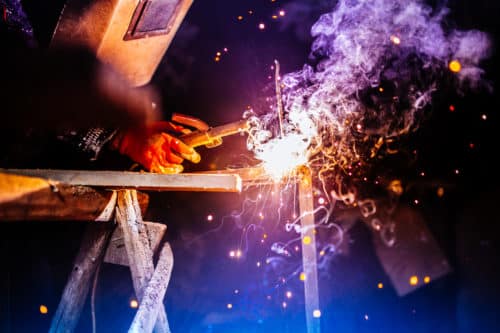
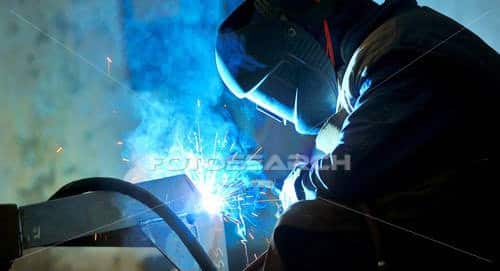
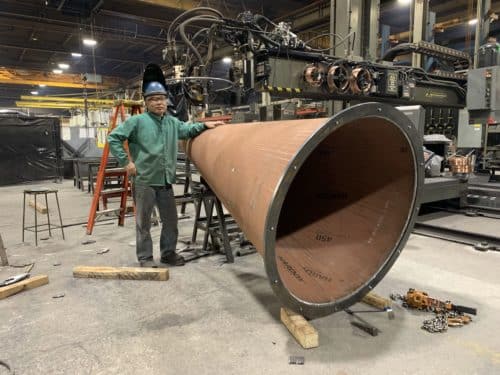 HARDOX® Wearplate is generally more formable.
HARDOX® Wearplate is generally more formable.






